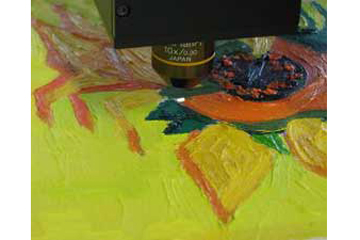Digital Fingerprints for Art Could Thwart Heists

When it comes to the art of pulling off the ultimate heist, there is little defense against precision and timing.
Rotterdam's Kunsthal museum is a shining example. Earlier this week, thieves embarked on a pre-dawn raid and made off with seven masterpieces, including paintings by Picasso, Monet, Matisse and Gauguin. Police said the stolen paintings -- valued at roughly $100 million -- represented the largest art theft in the Netherlands in more than two decades.
However, as heists have grown more sophisticated, so to have efforts to thwart the thieves. Take, for example, FING-aRt-PRINT, a European Union-funded project that aims to give art masterpieces a unique "digital signature" that could distinguish between works that are authentic, fraudulent and stolen.
"Using a combination of extremely accurate surface profile measurement -- essentially like a microscopic 3D surface of a small area -- plus extremely accurate color measurements of the same area, we believe it is possible to store a 'fingerprint' of the object, which would be impossible to replicate," Kirk Martinez, one of the project's partners and a Senior Lecturer in Electronics and Computer Science at the University of Southampton, explained to Discovery News.
Like fingerprints, each painting yields idiosyncrasies of roughness and color -- or chromatism -- that can be viewed at the microscopic level, making each print unique and easily identifiable.
From a distance of less than a half inch, researchers used a sophisticated microscope called a white light confocal profilometer to measure the "roughness" of one square centimeter of a painting. By pointing a special camera at the same spot, scientists created a spectral fingerprint that recorded how light bounced off the painting. Doing so provided valuable information about the paintings pigments and dyes. Finally, an image of the painting's fingerprinted spot is taken to record the exact location for future reference.
Sign up for the Live Science daily newsletter now
Get the world’s most fascinating discoveries delivered straight to your inbox.
ANALYSIS: Seven Masterpieces Stolen In Dutch Museum Heist
Developers say applications like this could be used to prevent forgery or theft. So, could FINGER-aRt-PRINT's technology have prevented the heist at the Kunsthal museum?
"Not necessarily," Martinez said. "The technology would need consistent use across art institutions and crime agencies."
Marc Masurovsky, a historian and expert in Washington D.C. who specializes in issues pertaining to plundered art, agrees.
"In a certain sense, it's like putting a tracer on objects," he said. "It could work as long as there's a whole infrastructure tracking these objects and enforcing the recovery of them."
However, some critics question whether FINGER-aRt-PRINT's technology can truly create a lasting signature since the roughness and chromatism of paintings deteriorates over time.
NEWS: Canadian Retiree to Claim Nazi-Stolen Art
Paintings "are not stable structures," said Masurovsky. "I see with my own mother's paintings, there's a yellow pigment that is slowly shifting to sort of an olive color. These are organic, metallic substances that, depending how they're made, will shift in time."
While Masurovsky sees the merit of digitally fingerprinting works of art, he also thinks less high-tech systems could work just as fine.
"There are a lot of factors that come in. Nobody has been able to set up a fool-proof system," he said. "I've always been party to using more old fashioned techniques like registering every object possible and creating these databases that are shared with law enforcement and communities that really care about this. But requests have gone unheeded for decades.
"Registration means that you can't engage in hanky-panky, because there's a tremendous amount of illicit activity in the art market. A lot of people want to buy things under the table."
While art museums may register their high-profile works, much of what visitors don't see can be vulnerable.
"You have to remember, museums only exhibit a small amount of their collections," Masurovsky said. "Have they registered what's in storage or in the warehouses? Same thing with governments. Have they been held accountable? The answer is no. We're talking about a subset of a subset of a subset."
Still, Masurovsky said technologies like FINGER-aRt-PRINT are a step in the right direction.
"It's a good idea. I'm not trying to pooh-pooh it," he said. "It's just that there's so many questions about an unregulated market place."
This story was provided by Discovery News.









